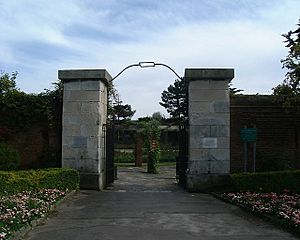Lumps Fort facts for kids
Quick facts for kids Lumps Fort |
|
|---|---|
| Southsea, England | |

Entrance to Lumps Fort
|
|
| Lua error in Module:Location_map at line 420: attempt to index field 'wikibase' (a nil value). | |
| Type | Fort |
| Site information | |
| Owner | Portsmouth City Council |
| Open to the public |
Yes |
| Condition | Mostly complete |
| Site history | |
| Built | 1859–1861 |
| Materials | Brick, earth |
Lumps Fort is an old fort located on Portsea Island in England. It was built a long time ago to help protect the important naval base in Portsmouth. Today, it's no longer used for military purposes.
History of Lumps Fort
Lumps Fort has been around since the 1700s. The first time it was mentioned was in 1805. Records from the Board of Ordnance, which was in charge of military supplies, noted that Lumps Fort had "three 32-pounder guns." These were large cannons used for defense.
By 1822, the fort was used for a semaphore line. This was a system of tall towers with movable arms. They sent messages by signaling with the arms, like a giant flag alphabet. This station was built here to avoid the smoke from Portsmouth town. The smoke could block the signals from Portsdown Hill. The fort stopped being used for defense by the 1820s. In 1827, part of the fort even fell into the sea. The semaphore station closed in 1847 when the electric telegraph took over. The telegraph was a much faster way to send messages.
Rebuilding the Fort
The fort was rebuilt between 1859 and 1869. This was part of a big project to improve defenses around Portsmouth Harbour. These new forts are often called Palmerston forts. They were named after Prime Minister Lord Palmerston.
The new design for Lumps Fort allowed for 17 guns. It also had a building at the back to house 100 soldiers. Usually, only a Master Gunner lived there. In 1885, this was a man named H Orchard. Volunteer Artillery units also used the fort for gun practice. For example, the City of London Artillery Volunteers trained there in 1889.
New Guns for Defense
In the 1890s, the fort got new weapons. These included three 6-inch rifled breech-loader Mk. IV guns. These were advanced cannons that loaded from the back. They were placed on special stands called hydropneumatic carriages. These carriages helped absorb the recoil when the gun fired.
These guns were removed in 1906. However, the fort was armed again in 1914. This was at the start of World War I. It became a battery to defend the beach. It had a 6-pounder Hotchkiss anti-aircraft gun. This gun was used to shoot down enemy planes. After World War I ended, the fort was mostly taken apart. Only its basic shape remained.
After Military Use
Portsmouth City Council bought the fort in 1932. Plans to develop the area were stopped by World War II. In 1942, a special military group started using the fort. This was the Combined Operations Development Centre's Experimental Party. Soon after, the Royal Marine Boom Patrol Detachment also arrived. This unit trained with special canoes and boats. They used two Nissen huts, which are simple, curved metal buildings, near the fort.
This detachment trained in the Solent, a strait of water nearby. They often paddled their canoes to the Isle of Wight. This unit later carried out a famous mission called Operation Frankton. They attacked German ships in Bordeaux harbour.
After the war, the fort area was turned into a rose garden. The eastern part of the site became the Southsea Model Village.
Next to the fort is the Canoe Lake. This lake was created from a large marshy area. It opened on June 17, 1886, and was used for boating. During World War II, the lake was used for important experiments. These experiments tested ways to protect against magnetic mines. Magnetic mines explode when a ship passes over them.



